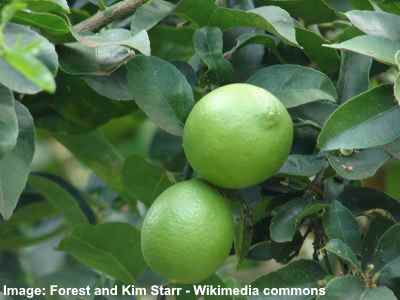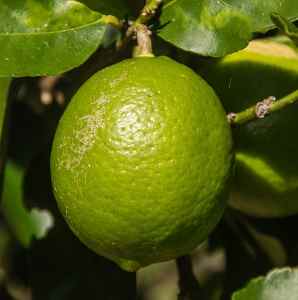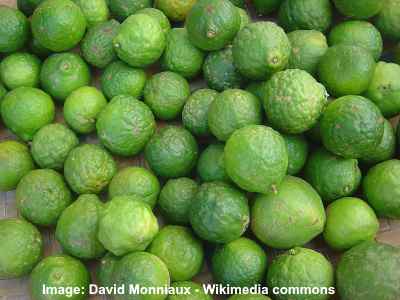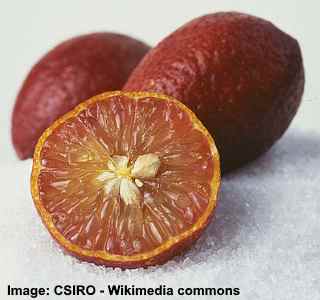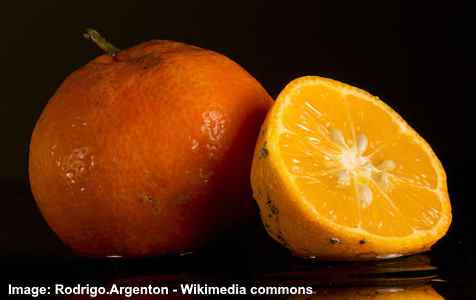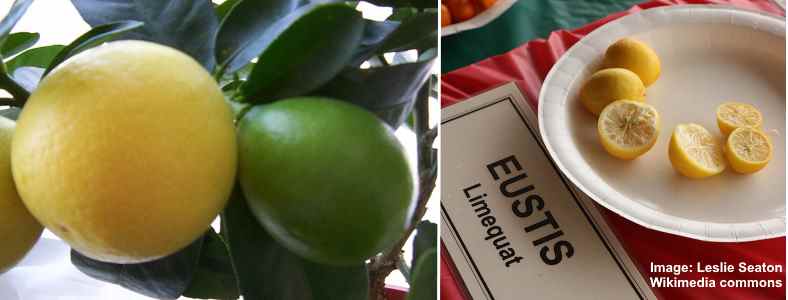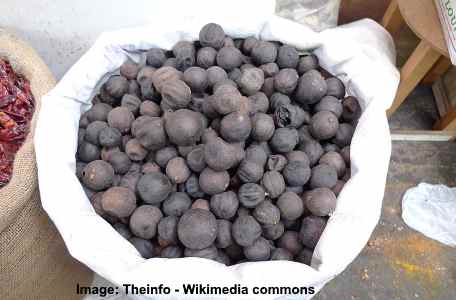Types of Limes: Varieties of Lime Fruit from Around the World (With Pictures)
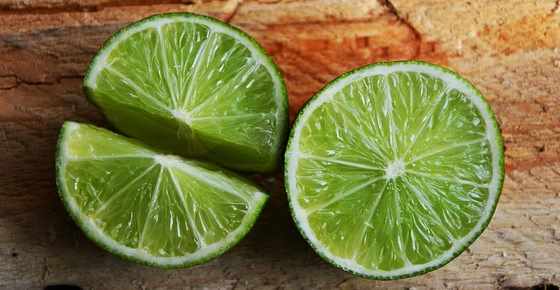
Lime fruit belong to the family of citrus fruits and usually have green, smooth zesty skin with hints of yellow. All types of limes are hybrid fruits that come in various shapes and sizes.
The most popular varieties of limes are Key limes, Mexican limes, Bearss limes, and Tahiti limes. Other varieties of limes include finger limes, kaffir limes with a bumpy skin, and Philippine limes with their orange flesh.
Lime fruits have similar taste to lemons – both are acidic with a slight difference in flavor and scent. Limes are usually less sweet and slightly bitterer than lemons, but this also depends on your personal taste. This means that limes have an important place in many types of cuisines. Lime juice and zest is the main ingredient of lime pie, also lime rinds are used for garnish and to infuse oils and vinegar, and many Mexican, Thai, and Vietnamese dishes include lime juice.
It is thought that limes originated in Indonesia and they became popular green citrus fruit in Mediterranean countries. Lime trees now grow in many countries such as India, Mexico, China, and the U.S.
In this article, you will learn more about the various types of limes and how to choose the best kind of limes for cooking with.
Types of Limes (With Pictures and Names)
Let’s look in more detail at the many and varied types of limes, starting with one of the most popular kind, the Key lime.
Key Limes (Mexican limes)
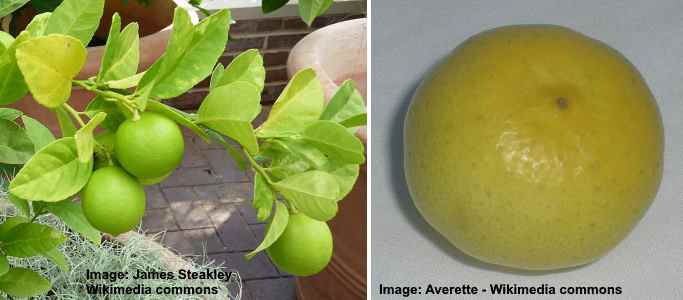
Key lime on the tree (left) and ripe yellow Key lime (right). When ripe, the color of this type of lime is bright yellow, unlike the more common green Persian limes.
Key limes (Citrus aurantiifolia) are a small type of round lime that has a strong acidic flavor and aroma. Key limes grow on thorny bush-like trees in many countries that have hot climates. Other names for this lime variety are Mexican lime, West Indian lime, or bartender’s lime.
Key limes are green fruits that grow to between 1” and 2” (2.5 – 5 cm) in diameter.
Compared to other types of limes such as Persian limes, Key limes are smaller and more yellow in color. The round citrus fruits are harvested from the lime tree while still green. They then gradually become yellow as they ripen and intensify in flavor. In fact, some people claim that Key limes are superior to lemons in terms of flavor, juiciness, and aroma.
Unlike Bearss limes, Key lime flesh contains a number of seeds. Another distinguishing feature of this type of Mexican lime is their acidic taste. It is because of their intense sour-sweet taste that they are widely used in cooking, baking, and to flavor cocktails.
The name of this lime cultivar comes from the Florida Keys where the lime trees once flourished. However, now, most of the Citrus aurantiifolia crop grows outside of the United States.
Other types of Mexican limes
As with Key limes, other types of Mexican limes also have strong aromas, thin rinds, and an acidic taste. Also, Mexican limes tend to be more yellow than green when fully ripe.
Here are a few other notable varieties of Mexican limes:
Mary Ellen sweet lime (Citrus limettioides) is a small round type of lime that is yellowish-green when mature. Because the flesh lacks acidity, it doesn’t have the sharp taste of other Mexican limes.
Thornless Mexican lime is now a popular type of lime-producing fruit tree due to its lack of thorns. Lime fruit from this cultivar taste similar to other Mexican limes and the fruit is easier to harvest.
Castello lime is a larger type of Mexican lime that is similar in taste to the traditional varieties from Mexico. This lime cultivar has good flavor and plenty of juice.
Bearss Limes (Persian Limes)
Bearss limes (Citrus latifolia) are one of the most popular varieties of limes in the world. Compared to Key limes, Bearss limes are larger, have an oval shape, and are less acidic.
Bearss limes grow on thornless lime trees and the fruit can grow up to 2.5” (6 cm) in diameter. These green-skinned citrus fruits are also a seedless variety of lime. Usually, if you buy limes in the store, it is types of Persian limes for sale. However, they turn greenish-yellow as they ripen fully.
One difference between Bearss limes compared to Key limes is that they are not as acidic or bitter. Also, Persian limes have thicker skin and longer shelf life than their Mexican cousins.
Tahiti Limes
Another type of Persian lime is the Tahiti lime. This lime fruit variety has a more oblong shape than round. Similar to Bearss limes (Persian limes), this is a seedless variety of lime.
When it comes to varieties of Persian limes, there is very little (if any) difference between Tahiti limes and Bearss limes. Both are larger than Mexican limes with a juicy flesh that is also less acidic.
Kaffir Limes
A type of lime popular in Asia is the Kaffir lime (Citrus hystrix) with its lime-green color and distinctive bumpy skin.
As with many types of limes, Kaffir limes turn somewhat yellow as they ripen. However, when compared to other types of lime fruit, Kaffir limes are extremely tart and usually too acidic to cook with. Kaffir limes also contain very little juice when compared to Mexican and Persian limes.
Kaffir limes are much smaller than other types of limes with the fruits only being about 2” (4 cm) wide.
Due to their lack of juice, other parts of Kaffir limes rather than the flesh are used in cooking. For example, the rough rind of these small citrus fruits contains a lot of essential oil. Also, Kaffir lime peel is often an ingredient in Thai curry dishes to add acidity and flavor. Leaves from the Citrus hystrix bush are also dried and used to flavor many Asian dishes.
Calamansi Limes (Philippine Limes)
Philippine limes (Citrus microcarpa) are a hybrid type of lime fruit that looks like a small green lime but has orange-colored flesh.
This type of small citrus fruit grows in the Philippines and southern Asia. In other countries, it is called calamondin. Philippine limes sometimes only measure about 1” (2.5 cm) in diameter.
The juice from calamondins can be quite sour but the ripened rind is quite sweet. The unusual feature about these limes is that they look more like a small tangerine when fully ripe. Because of this, whole or halved Philippine limes are often used in certain dishes for their flavor and decorative value.
In countries outside of Asia, calamansi limes are popular ornamental fruit-producing shrubs. They grow well in pots and containers in sub-tropical climates and can make attractive houseplants.
Finger Limes
One of the most unusual types of limes is the Finger Lime (Microcitrus australasica). Other names for this citrus fruit include the Australian finger lime or caviar lime.
Apart from its lime-green color, this seedless citrus fruit doesn’t look like a typical lime. The fruit is cylindrical and has a long shape with an apex at one end and rough, bumpy skin. Finger lime fruits can measure up to 3” (8 cm) long and may look more like a short type of cucumber.
The name of this citrus fruit – “caviar lime” – also gives a clue to a unique feature of it. The flesh of finger limes looks like small caviar pearls rather than typical oblong citrus fruit juice sacs. Biting into these lime pearls releases tangy, sour juice that has a refreshing taste.
Different varieties of finger limes have colors such as lime-green, red, light yellow, and light pink.
You can use the fleshy pearls from Finger limes as a garnish for various foods. The pearls go well with seafood, chicken, and can even give a delicious sour kick to some desserts.
Blood Limes
Blood limes are another unusual type of lime fruit due to their red color and sweet tangy taste.
Compared to traditional types of limes, blood limes are fairly small. Their red egg-shaped fruits only measure about 1.5” (4 cm) long and 0.7” (2 cm) wide. However, unlike other lime varieties, you can eat the skin along with the flesh of blood limes.
This red lime variety was developed by crossing a red finger lime with a type of mandarin hybrid or Rangpur lime. This resulted in small blood-red, sweet limes with lightly pitted skin.
Rangpur Limes
Despite their name, Rangpur limes (Citrus jambhiri Lush.) are actually a cross between a citron fruit and mandarin orange. Some people class this fruit as a type of Indian Mandarin lime.
Even though Rangpur limes look like a small orange, their acidic taste closely resembles that of a traditional lime. For this reason, they are often found on the list of exotic limes.
One of the most common uses of Rangpur limes is to make marmalade. In fact, in areas where these limes grow, they are the preferred choice over Seville oranges for marmalade.
Limequat
Limequats (Citrus floridana) are a type of lime that has bitter-sweet flesh and sweet-tasting skin. This type of lime cultivar is a cross between Key limes and kumquats
Limequats are a small citrus fruit that are green, before turning lemon-yellow as they ripen. This means that fully ripe limequats look more like lemons than limes. However, their light green flesh tastes more like a lime.
Limequats grow in many countries including the United States, Spain, Malaysia, Japan, and Israel. Limequat trees are hardier than lime trees and can survive temperatures as low as 50°F (10°C). In cooler climates, limequats grow well in containers or pots as ornamental houseplants.
The 3 limequat cultivars available include Eustis, Lakeland, and Tavares.
Omani Dried Limes
Omani dried limes are a small type of lime that are dried and used as a spice to flavor Middle Eastern dishes. These dried limes are also called black lime, loomi, limoo amani or Noomi Basra.
The small limes are dried in the sun and then used to give a strong citrusy flavor to various dishes. There is a distinct taste of lime from dried limes along with overtones of earthiness and smokiness.
If you want to try the unusual taste of dried Omani limes, you can buy them online or from specialized food stores.
How to Pick Ripe Limes
When choosing limes to use in the kitchen, it’s important to know when limes are ripe. Sometimes, it can be difficult to tell the difference between an unripe lime and a fully ripened one.
Limes are generally harvested while they are still green and not yet completely ripe. The most popular types of limes you can buy in the store – Tahiti lime, Persian limes, or Key limes – tend to be yellowish-green rather than dark green when they are at their tastiest.
Here is how to choose a ripe lime:
- If choosing a Persian lime, check to make sure the color of the rind is light green with hints of yellowing. Mexican limes have the best flavor when they have just turned yellow.
- Feel the skin to see how smooth it is. Ripe limes should have smooth skin with very few dimples or pits.
- Gently squeeze the lime. When they are ripe, the rind should give a little and not be too hard.
- Compare a couple of limes and choose the heaviest ones. These are juicier and will have more flavor.
What’s the Difference Between Lemons and Limes?
The main differences between lemons and limes are their color and taste. Of course, the terms “lemon” and “lime” are also good descriptions of shades of yellow and green colors.
Although all types of lemons and limes belong to the citrus genus, there are some differences and some similarities between them.
Due to the fact that limes are more acidic, their flavor tends to be stronger and bitterer than lemons. However, the tartness of limes such as Key limes can go well with sweet dishes such as Key lime pie.
Usually, when deciding whether to use lemons or limes in cooking is just a matter of personal taste.
Related article: Amazing Lemon Varieties with Pictures From Around the World

